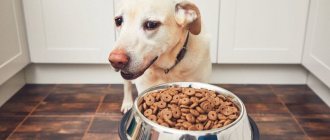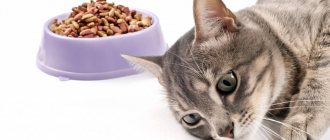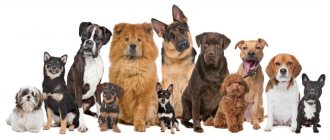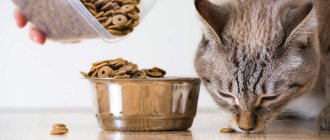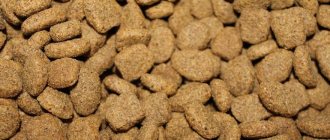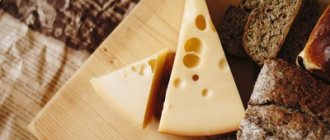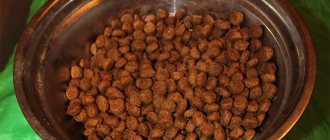Choosing a dry diet as the main food for dogs is a convenient, practical and affordable option that will simplify the life of the owner and maintain the health of the pet. It would seem that everything is simple, you just need to read on the packaging how much food to give your dog, measure out the required amount of dry granules and pour them into a bowl. In reality, many problems and questions arise. From the article you will learn: how the daily intake depends on the energy value and class of food, what to do if the dog does not eat enough of the recommended portion, how much water is needed and when it is necessary to review the amount of food given to the dog.
Should you feed your dog only prepared food or use a mixed diet?
Before we find out exactly what portion of dry food a dog needs every day, let’s find out whether it is possible to feed the dog exclusively with dry granules or canned food. Many owners worry that such a diet is too monotonous and can lead to negative consequences. To avoid this, they switch the pet to a mixed diet - mixing meat directly into a bowl of dry granules or replacing one of the meals with natural products.
Let's highlight the main risks that a dog's mixed diet carries:
- the combination of dry food and meat products can lead to excess protein. Its excess puts additional stress on the kidneys and liver. The result is kidney failure, liver dystrophy, allergic reactions;
- the combination of dry pellets and fish leads to an excess of phosphorus. The result may be urolithiasis. In addition, there is a critical decrease in the level of leukocytes. Minor hemorrhages appear. Bones lose calcium and accumulate phosphates. In adults this leads to osteoporosis, in children to rickets;
- a mix of dry food and porridge leads to an excess of carbohydrates in the body. This situation threatens the rapid development of obesity and all the ensuing consequences.
Constant menu changes actually terrorize the gastrointestinal tract, forcing it to produce different types of enzymes. Such intense work leads to gastritis and peptic ulcers.
Opponents of dry food talk about the risks that a monoration poses. First of all, they note a negative effect on the mucous membranes, especially when the daily norm is exceeded. Despite the qualitative differences in dry diets depending on the class to which they belong, there is no negative effect on the mucous membranes. Before entering the market, all dry food undergoes laboratory testing. All of them are produced with a monoration in mind, so high-quality products contain the entire necessary set of minerals, vitamins and microelements.
Important: of course, it is worth considering the presence of diseases in your pet. Particular attention should be paid to gastrointestinal problems. If a veterinarian recommends giving up dry food and switching to a natural diet, this must be done.
Why do you need to define the norm?
Determining the daily feeding rate is very important. Overfeeding or underfeeding will lead to health problems. Dogs cannot control their food intake on their own. Some breeds, such as pugs or dachshunds, will eat whatever is in their bowl. This behavior has a genetic reason - in nature, the ancestors of dogs did not get prey every day. Of course, domestic dogs are freed from the need to get their own food, but unlimited access to dry food leads to excessive consumption.
Interesting: some manufacturers put a special measuring cup in the package with dry food, which is very convenient for measuring portions for your pet. It is worth remembering that such measuring containers are only suitable for granules from a certain manufacturer and cannot be used for others.
Examples of diet for puppies of different breeds
Puppies of different dog breeds also differ in weight and size. In addition, they grow and develop differently. For some, a small portion of food is enough, while others will need several times more.
Puppies of small breeds (for example, Yorkies) have an accelerated metabolism, so they mature quite quickly. Closer to a year, they can easily be switched to food for adults. Approximate calculations are described in the table.
| Adult dog weight (kg) | 2-3 | 4-6 | 7-9 | 10-13 | 14-16 | 17-19 | 20-22 | 23-25 |
| Puppy age (months) | ||||||||
| 2 | 65 | 100 | 125 | 160 | 190 | 215 | 240 | 240 |
| 3 | 70 | 110 | 145 | 190 | 225 | 255 | 295 | 295 |
| 4 | 75 | 125 | 155 | 205 | 240 | 275 | 315 | 320 |
| 5 | 75 | 125 | 155 | 205 | 245 | 280 | 325 | 335 |
| 6 | 70 | 125 | 155 | 205 | 245 | 280 | 330 | 350 |
| 7 | 60 | 110 | 140 | 185 | 230 | 260 | 325 | 350 |
| 8 | 55 | 100 | 125 | 170 | 210 | 245 | 295 | 315 |
| 9 | 90 | 110 | 150 | 195 | 225 | 265 | 285 | |
| 10 | 90 | 110 | 150 | 175 | 200 | 235 | 250 |
Large dogs (bulldogs, German shepherds, Rottweilers and the like) have a slow metabolism, so they mature later than kids. Despite the fact that the dog looks like an adult, all his organs and skeleton continue to develop, so he needs enough useful nutrients. Veterinarians often recommend giving large dogs puppy food until they reach 2 years of age. An approximate calculation is described in the table below.
| Adult dog weight (kg) | 26-29 | 30-33 | 34-37 | 38-44 | 45-54 | 55-64 | 65-74 | More than 75 |
| Puppy age (months) | ||||||||
| 2 | 255 | 245 | 260 | 295 | 380 | 395 | 415 | 440 |
| 3 | 310 | 315 | 340 | 390 | 450 | 505 | 550 | 580 |
| 4 | 345 | 355 | 390 | 435 | 490 | 555 | 615 | 645 |
| 5 | 390 | 420 | 460 | 515 | 580 | 660 | 730 | 770 |
| 6 | 435 | 460 | 525 | 590 | 655 | 750 | 835 | 880 |
| 7 | 435 | 480 | 525 | 590 | 660 | 755 | 845 | 890 |
| 8 | 405 | 445 | 490 | 585 | 655 | 755 | 850 | 895 |
| 9 | 375 | 415 | 460 | 545 | 675 | 780 | 925 | 975 |
| 10 | 345 | 380 | 430 | 510 | 660 | 765 | 910 | 960 |
| 11 | 315 | 345 | 400 | 465 | 640 | 740 | 890 | 935 |
| 12 | 375 | 425 | 625 | 720 | 860 | 905 |
These are just approximate data. The owner should monitor his pet and, if necessary, slightly reduce or increase the portion.
It is important that your dog always has clean water next to his dry food.
How to calculate the amount of food for a pet
Since we are talking about ready-made food rations: dry and wet, we will need to take as a basis tables with recommended daily intakes placed by manufacturers on food packaging. However, the owner will have to take into account a number of individual factors that distinguish his dog. These include:
- Age category of the dog (puppy, young or elderly dog);
- Weight (can be normal, overweight or underweight);
- Dog activity (number and duration of walks, physical activity during the day);
- State of health (presence of chronic diseases, pathologies);
- Physiological condition (pregnancy, lactating bitch, recovery from illness or surgery, and others).
The tables from the manufacturer indicate the recommended daily intake of dry food. Quite often they are significantly overestimated; manufacturers are simply not able to take into account all the characteristics of your pet.
It is necessary to collect all individual information about the dog and determine the brand of food for which the calculation will be made. It is better if dry food is selected by the owner together with a veterinarian, since it is not always possible to independently take into account all the medical contraindications of the animal. The use of a dry diet can lead to serious kidney problems and a serious allergic reaction - advice from a specialist in selecting food and determining the portion size is simply necessary.
What is meat for?
Although dogs have been around people for many years, they are carnivores, so protein is very important for replenishing nutrients and energy.
Dogs' bodies are excellent at digesting raw meat products. It is this food that has the most positive effect on them:
- Sharp and powerful molars and canines can be seen in the mouths of most small breeds, not to mention impressively sized dogs. Thanks to these “tools” they can crush and chew sinews and muscles.
- Abundant salivation and the high level of acidity of the large stomach contribute to the efficient digestion of raw meat without risk to health.
- The intestines are quite short, which indicates that the main element of the diet clearly cannot be cereals or herbs, since in this case the beneficial substances will not be able to be absorbed and enter the blood. In a healthy dog, the duration of a complete food digestion cycle is approximately 24 hours.
Almost all domestic and wild canid animals are ready to eat other types of food, including grains and vegetables. However, they act only as additional sources of nutrients, since the key part of the energy is provided by the main products.
Types of dog food
One of the most important indicators of dry food is its relationship to a certain class and the energy value of such a diet. There are types of dry food:
| View | Energy value (Kcal/100 g) | Compound | Recommendations | Example |
| Economy | 250-300 | Poor composition, based on grains and corn. Contains aromatic additives and dyes. A large portion is needed to satiate the dog. | Should not be used for regular feeding of dogs. Requires the use of additional vitamin and mineral complexes. | Chappie, Oscar, Meal, Favorite, Our brand, ProTail, Darling, Pedigree. |
| Premium | 300-350 | Higher protein content (about 20%), mainly due to offal and meat production waste. The composition contains vitamins and minerals, fiber. | Suitable for everyday nutrition, requires vitamin supplements adjusted for the physiological state of the dog. | Royal Canin, Brit Premium, Monge, |
| Super premium | 360-450 | The most balanced diet, with a minimum content or complete replacement of grains, a maximum content of meat (up to 75%). A complete complex of vitamins and minerals. | Suitable for daily feeding of dogs, no additional feeding is needed. | Akana, Eukanuba, Grandorf. |
| Holistic | 360-450 | Difference from the super premium class: the ingredients that make up the food are approved for use in the human food industry. | Maximum benefits, recommended for use in dog nutrition. | Landor, G.O., Canidae, Grandin. |
The daily amount is indicated by the manufacturer based on the normal physiological weight of the animal, and not the actual weight. If your dog weighs much more than is expected for a certain age, this is a reason to contact the veterinarian.
There is no direct relationship between the amount of dry kibble in your pet's bowl and how quickly he becomes satiated. A dog can eat a “bucket” of economy class pellets and remain hungry. Don’t think that buying low-grade food will save you money.
How to determine the weight for one serving
There are several ways to determine portion weight.
- Weighing. After placing a certain amount of granules in a bowl, place it on the scale and record the result. Remove/add granules as needed. Don't forget to take into account the weight of the bowl.
- Using dispensers. You can purchase suitable measuring spoons or glasses and use them to measure the required portion weight.
- Determination by eye. It is acceptable if you have fed the animal several times and can imagine how large the portion given looks like.
Dry food
There are average feeding rates, according to which the daily dose is divided by the number of feedings. Most often, this standard is indicated in grams or in the number of measuring cups. 1 measuring cup = 240 ml (about 100 grams).
If necessary, dry granules can be softened with liquid: for puppies under 4 months of age, for older dogs or those with gastrointestinal problems.
I do this with different liquids depending on the dog’s preferences.
You should not prepare a large portion of soaked food, so as not to throw away an expensive product. Experts note that in the warm season, many animals refuse the softened product, preferring to drink dry granules with water.
Drinking regime for “dry feeding”
If the animal is fed only dry foods, then the required daily amount of liquid is calculated using the formula: 50 ml of water per kg of body weight.
Of course, you don’t need to give your dog water at certain intervals. She should have a free approach to drinking water and satisfy her own needs. And needs may vary depending on numerous conditions: age, physical activity, time of year, etc.
The water should always be clean - it needs to be changed every few hours. If this is not possible, a special automatic drinking bowl for dogs will come to the rescue. You should not use boiled water: the best option would be filtered or bottled water without gas. Raw water is strictly prohibited.
Rules for soaking dry food
If for some reason the amount of dry food is soaked, it is recommended to adhere to the following rules:
- use clean drinking water (can be bottled or filtered), but not boiled. Temperature - 40°C;
- The ratio of liquid to dry product depends on the preferences and age of the dog, and the manufacturer’s recommendations. Possible ratios (water:feed) - 1:2, 1:3;
- In addition to water, you can use low-fat fermented milk products - yogurt or kefir. The diluent should not be sweet, the temperature should be room temperature;
- the daily feed intake is not increased or decreased. Only the consistency of the portion changes.
Important: soaked dry food should be eaten within 2-3 hours. At any temperature, such food quickly sours and is inseminated by bacterial flora. If fermented milk products are used, it is necessary to carefully monitor the animal's stool. Minor liquefaction that resolves quickly should not cause alarm. If diarrhea continues for a long time, it is necessary to stop soaking dry food and consult a veterinarian.
The manufacturer may set a limit on the soaking of dry granules, which should be noted on the food packaging.
Photo: pixabay.com
Which variety should I choose?
The most common and common option is beef. It contains many useful elements and is not high in fat. Its use is completely safe for a dog that lives within the city. Many pets eat this kind of meat throughout their lives.
In addition to beef, dogs can be given the following varieties:
- Mutton. The daily portion should be limited, since meat is higher in calories. The optimal solution for herding and guard dogs. Lamb is very often chosen by shepherd dogs.
- Rabbit meat. Quite a dietary product that is recommended for small dogs. Not the best solution for constant use, which is associated with an increased amount of components that cause joint and kidney diseases.
- Veal. The meat is quite young, so it does not contain all the important enzymes. Excessively “empty” meat for the average pet.
- Horsemeat. A very easy option, which also should not be given daily. Many dogs do not like meat and frequent consumption of it can cause an allergic reaction.
- Venison. The most preferred option in the Far North, which is used instead of beef. The product contains a balanced set of elements.
- Bird. Turkey and chicken meat are often purchased as part of a diet or to save money. It is important to remove fat and skin, and remember that this is not the best option for dogs. The first reason is the use of hormones when raising poultry. The second is that chicken often contains parasite larvae.
- Giblets or offal. An ideal solution for variety, but cannot replace full-fledged meat. Often, pet owners choose unprocessed beef tripe.
Remember that feeding pork to dogs is not recommended. This is an excessively fatty product that contains almost no useful elements. The animal's stomach is not able to fully digest this meat, so you are simply throwing money away. In addition, the dog's health will suffer.
Wet food
Soft canned food has exactly the same division into classes as dry food. This means that the higher the class of food, the greater its energy and nutritional value, which means that less of it will be needed to saturate.
However, it is not recommended to completely switch the animal to feeding canned foods - soft food can cause problems with the gastrointestinal tract, constipation or loose stools, and the risk of tartar formation increases, since there is no mechanical cleaning of plaque.
| Type of dog | Daily calorie requirement (kcal) | Combined diet (dry + wet) (g) Pedigree | Only wet (100%) (gr) Using Pedigri as an example |
| Miniature (2-5 kg) | 250-350 | 40-50 | 300-400 |
| Small (6-10 kg) | 360-550 | 50-100 | 400-700 |
| Medium (12-24 kg) | 600-1050 | 100-250 | 800-1300 |
| Large (26-40 kg) | 1100-1550 | 200-300 | 1400-2000 |
| Very large (45+ kg) | 1600-2500 | 300-550 | 2050-6000 |
Feed classes and their energy value
For the convenience of the owner, the quality of feed is indicated by classes. There are four classes of feed:
- Economy class feeds are considered the most affordable. When performing a comparative analysis of economy and premium class feeds, it turns out that their prices differ slightly.
- Premium products contain more plant carbohydrates, which makes the food unsuitable for feeding dogs with allergies.
- Super-premium food is usually well balanced, containing enough proteins and all the necessary vitamins and microelements.
- Holistic class food , like super-premium products, is optimally balanced, but is made from higher quality raw materials. Manufacturers of holistic feeds claim that they use products suitable for human consumption as raw materials.
Daily food intake for puppies
| Puppy age (in months) | Number of meals per day | Daily kcal norm per 1 kg of weight in |
| Up to 1 | 6 | 220-250 |
| 1-3 | 5 | 260-280 |
| 3-4 | 4 | 200-230 |
| 4-8 | 3-4 | 120-150 |
| 8-12 | 2-3 | 100-130 |
Small breeds of puppies
Puppies of small and miniature breeds develop very quickly due to increased metabolism; at 6 months, such a miniature dog puppy is already very similar to an adult dog. Therefore, during the period of intensive growth, such babies need high-calorie food, which allows the animal’s body to properly form in such a short time.
| Age\weight (months) dog weight up to 10 kg | Super premium diet (using Akana as an example, value about 450 kcal) | Economy (using the example of Our Brand, value about 300 kcal) |
| 1-3 | 15-80 gr | 45-100 gr |
| 3-4 | 17-115 g | 60-200 gr |
| 4-6 | 20-120 gr | 70-250 gr |
| 6-12 | 25-125 gr | Feed used for adult animals |
Photo: flickr.com
Large breeds of puppies
Large breed dog puppies need a diet rich in protein and calcium for muscle growth and healthy skeletal development. Their development occurs spasmodically, at six months of age they look more like ugly ducklings rather than adult dogs. The heart muscle also requires special nutrition, which must receive all the necessary elements for further uninterrupted operation.
| Dog's age/weight | Super premium diet, value 400 kcal (using Grandorf as an example) | Economy food, value 300 kcal (using the example of Pedigree) |
| 1-3 (from 5 to 70 kg) | 50-220 gr | 400 gr |
| 3-4 (from 25 to 70 kg) | 230-330 gr | 450-530 gr |
| 4-6 (from 25 to 70 kg) | 260-500 gr | 550-600 gr |
| 6-12 (from 25 kg) | 250-800 gr | 650-900 gr |
Feeding frequency
The frequency of feeding directly depends on the age and size of the dog:
| Age of the dog, in months | Number of meals per day |
| 0–1 | 6–10 |
| 1–2 | 5–6 |
| 2–3 | 4–5 |
| 4–6 | 3–4 |
| 6–12 | 3–2 |
| 12+ | 2 |
The table shows that the smaller the dog, the more often it should receive food. Fractional feeding is used to prevent gastric overdistension. If a puppy eats forcefully from an early age, the muscles of the stomach walls lose elasticity.
In adulthood, a distended stomach causes overeating and obesity. Dogs that regularly transmit suffer from metabolic disorders.
Daily food intake for adult dogs
| Normal dog weight (kg) | Norm of dry granules per day (g) with normal activity | Norm for high animal activity (in g) |
| 1.5-6 | 50-110 | 100-200 |
| 6-10 | 115-150 | 215-290 |
| 10-16 | 155-230 | 300-410 |
| 16-23 | 235-290 | 420-550 |
| 23-35 | 295-400 | 560-630 |
| 36-45 | 410-500 | 700-900 |
| 45+ | 510 + 50 g/ 5 kg weight | 800 + 100 g\ 5 kg weight |
For a pregnant bitch, the daily intake of an adult dog (by weight) is increased by 25-50% depending on appetite, in consultation with a veterinarian. It may be worth giving up food intended for adult dogs and using a diet for puppies. A portion of such food is calculated according to the rule: the daily norm of an adult healthy individual with normal activity + 25-50%.
Daily food intake for older dogs
Upon reaching the age of seven, the pet needs to review its diet and the amount of food consumed. During this period, chronic diseases and pathologies worsen, and metabolism slows down. The dog needs additional minerals, but not an increase in food portions. It is worth changing the food, choosing one that contains special markings.
Let us note that with age, most animals’ need for rest and sleep increases, but food preferences change greatly: from uncontrolled food consumption to refusal of it.
If your dog has problems with the gastrointestinal tract or teeth, you should start soaking the granules or switch to wet canned food.
| Dog weight (over 7 years old) in kg | Daily value (in g) | Daily value in a cup (1 measuring cup about 100 g) |
| 1,5-5.5 | 35-100 | 1\3-1 |
| 5,5-9,5 | 110-150 | 1-1,5 |
| 10-15 | 160-210 | 1,5-2 |
| 16-23 | 220-300 | 2-3 |
| 24-35 | 310-380 | 3-3,5 |
| 36-45 | 390-470 | 4-4,7 |
| 45+ | 480 + 50 g/ 5 kg | 5+ |
How to cook dog porridge with meat
From experience, we can say that for proper nutrition, you need to feed your dog porridge with meat 2-3 times a week. Pearl barley, oatmeal, and wheat porridge will bring benefits, but buckwheat is the most beneficial. It contains many useful minerals, and besides, it helps the dog lose weight and cleanses the circulatory system.
Therefore, next we will describe the process of preparing buckwheat dog porridge. Preparing such a dish is not difficult. In the evening, pour cold water over buckwheat and leave overnight. To cook porridge, you will need to take 1 part buckwheat and add 2 parts water. This porridge is cooked for 15 minutes, after which it is infused in the pan for the same amount of time.
During the cooking process, you can add chopped meat to the porridge. Before adding to the porridge, the meat must be boiled to prevent possible infection of your pet. The total volume of meat should be approximately 1/3 of the volume of porridge.
Many dogs love to crunch on cucumbers.
As for additives and seasonings, it is advisable to avoid adding salt to porridge, but a teaspoon of vegetable oil will be very useful.
How much water does a dog need when eating dry food?
Water is the basis for proper digestion and metabolism. In order for your dog’s body to receive all the necessary substances from their dry food, you must strictly follow the rules for providing it with water:
- The daily water intake depends on the dog’s weight and the portion of dry food consumed;
- For 1 kg of animal weight, about 40-60 ml of water is required;
- Puppies need more fluid - about 80-100 ml per kg;
- Monitor your pet's behavior - if he eats exclusively dry food, he may need more water than normal;
- If the ambient temperature drops below +20, the dog can reduce its fluid intake.
A bowl of clean, fresh water should always be available to your dog. Monitor your fluid intake - deviations from normal behavior should alert you and this is a reason to consult a doctor. Don't get dehydrated!
Photo: wikimedia.org
Should the meat be cooked or raw?
Raw meat brings maximum benefit to animals, as it contains a lot of protein and important components. But don’t rush to give your dog fresh meat from the market stall.
Meat often contains dangerous microorganisms and parasite larvae. Therefore, it is better to pre-freeze it at a temperature of at least -15 °C. If this is not possible, it is recommended to boil the products. We must take into account that heat treatment kills part of the protein, so the amount of meat will have to be slightly increased.
If the dog does not eat enough dry food
All these rather complex and sometimes inaccurate calculations are needed to ensure that the dog does not starve and receives the maximum amount of nutrients from the food it eats. Of course, if a dog is constantly begging for treats and food from the owner’s table, this does not mean that the portion of food is not enough for him. However, you should carefully ensure that the offered portion is enough. Symptoms of deficiency may include:
- after feeding, the dog does not leave the bowl, freezes, waiting for more;
- the dog’s ribs, pelvic bones and scapular edges are clearly visible;
- the hunger pit is pronounced;
- the fat layer is thin.
These signs indicate that the dog is underweight. This can be either a consequence of the disease or insufficient nutritional value of the daily diet. In this case, the owner must:
- Visit your veterinarian to rule out your pet losing weight as a result of illness. For example, infections with parasites;
- if the dog receives super premium or holistic food, it is worth increasing the portion. Perhaps the animal’s physical activity has increased, its physiological state has changed, the cold season has arrived - all these are reasons to increase the proportion of dry granules in the bowl;
- if feeding is carried out with a diet of a lower class, choose higher quality, high-calorie and energy-rich dry food. It is better to choose an option, buying it in small packages in order to choose exactly what your dog will like;
- You can switch your dog to a mixed diet according to the following scheme: wet canned food + dry granules. Canned food is more nutritious and is often more appealing to animals.
Portion volume
If your pet eats dry food, then there are usually no problems with determining the daily serving amount. Many manufacturers of dog food mixtures already indicate the required amount on the packaging - it is indicated in the form of a plate in which the feeding rate is indicated opposite the weight.
To determine the amount of dry food needed, the owner needs to know the weight of the animal. Then the specified amount must be divided by the number of feedings per day. The result is the volume of a single serving.
If the dog eats only natural food, then the calculation is performed completely differently. The daily intake for natural feeding should be about 2-4% of the pet’s total weight. For example, if a dog weighs 8 kilograms, then he should eat an average of 160-320 grams of food per day.
However, the numbers may depend on many factors - the animal’s physical activity, lifestyle, and living conditions. In addition, the nutritional value of prepared dishes can affect the size of portions; for example, porridge with vegetables will be much lower in calorie content than meat.
If a dog eats natural food, its diet should include the following types of food:
- meat. The indicator of this component should be 30-50% of the total volume of food consumed;
- cereals – 25-35%;
- dairy products – 20-30%;
- vegetables – 15-20%;
- fish;
- fruits.
Learn about dog food allergies>>>
Why is underfeeding bad?
If exceeding the norm threatens obesity, then what is wrong with underfeeding? A deficiency of nutrients that the dog does not receive from the daily diet will have a bad effect on the dog’s health - the animal’s bones and internal organs will suffer. This is especially true for pregnant and lactating bitches. Underfeeding is dangerous for a puppy or a bitch that has just given birth.
During the period of feeding puppies, the feeding rate is increased - in this case, the food can be left in the animal’s bowl without restricting it. Even if she eats 200% of her daily allowance, that's okay. Malnutrition threatens not only the deterioration of the health of the mother with a tail, but also of the puppies, since the quality of milk decreases.
Important: if during the feeding period the bitch cannot eat a lot of food, and she loses weight, it is worth consulting a specialist. It would be better to switch the animal to a higher-calorie type of dry food.
How to make the calculation yourself
Calculating the amount of dog food yourself is quite simple and does not require much effort. To get the desired result, you need to divide the daily calorie intake by the energy value of the feed. In addition, it is worth taking into account the weight, age, activity of the pet, and the characteristics of its health. It is also recommended to consult a veterinarian.
Some manufacturers include measuring cups in the packaging
Briefly about the main thing
- Super premium and holistic dry food is best suited for feeding a dog;
- Dry food is digested much faster than natural food - it is worth feeding the animal three times a day in small portions, dividing the daily intake by the number of feedings;
- The dog’s diet should be based on its age, weight, health status and other individual characteristics;
- You can combine dry granules and wet canned food;
- The manufacturer provides the recommended serving size, it is a guideline;
- Small and large breed dogs have different nutritional needs;
- The dog should always have clean, fresh water available.
How do you calculate the required portion of food for your pet? Which food was chosen: economy or super premium? What differences in serving size have you seen? Share your experience in the comments to the article, please. Your opinion is very important to us.
Conclusion
Natural nutrition is as close as possible to the dog’s diet in its natural habitat. Therefore, if you have the time and desire, you can always create a balanced and healthy diet for your pet, which will be the key to your dog’s health and longevity.
By the way, if you decide to switch your pet from natural feeding to dry food, you need to do this gradually, over 10-14 days. At the same time, during the transition period, probiotics should be added to the dog’s diet daily.
